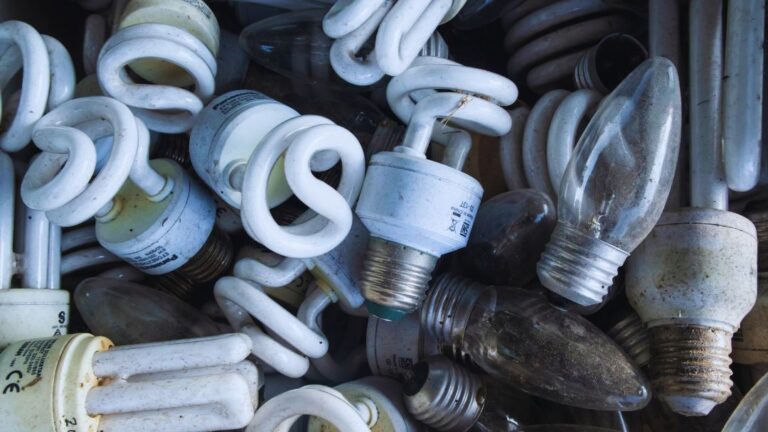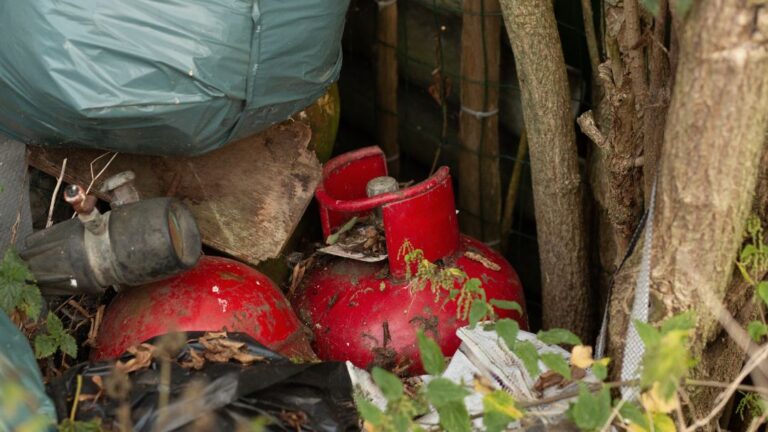Waste materials are generated by businesses in the process of their daily operations. From a manufacturing facility to auto repair shops, there is that very important question that every business in the U.S. has to face: Is this waste hazardous?
Many small businesses struggle with waste identification that affects working order, legal compliance, and bottom lines. Wrong classification puts a person in violation of regulations, levying heavy fines, and possible hazards to the community.
This guide covers the 4 characteristics of hazardous waste listed under federal regulations that businesses are required to identify. We will discuss ignitability, corrosivity, reactivity, and toxicity with real-life examples from industries.
The article provides classification methods, testing procedures, regulatory compliance requirements, and cost-effective disposal strategies that protect both your business and the environment.
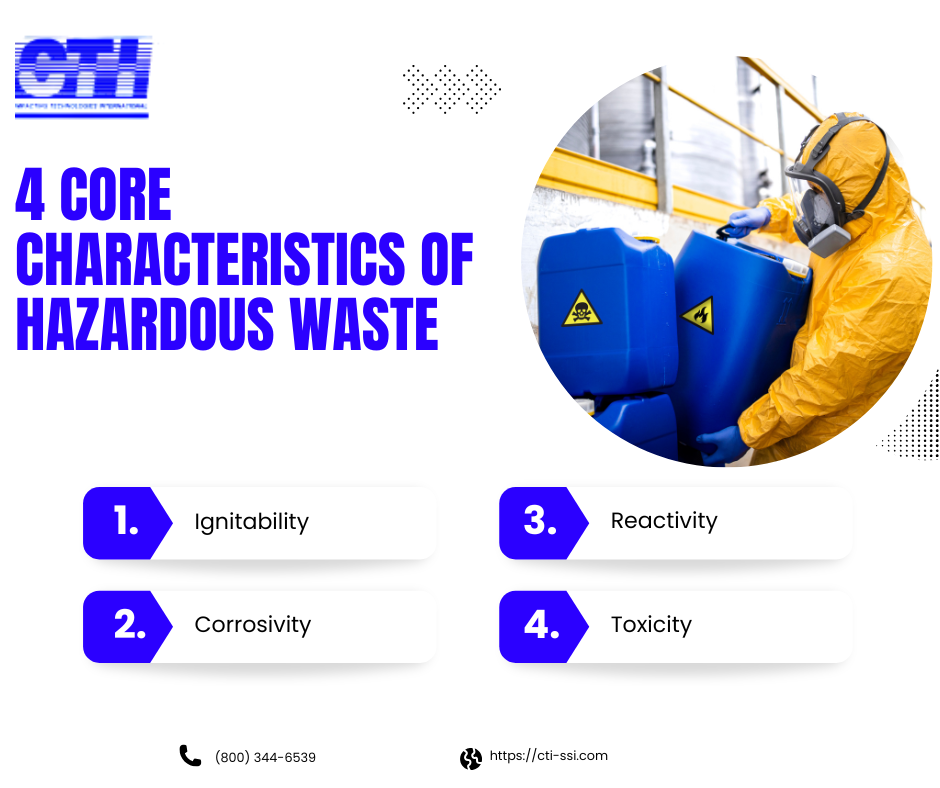
The Four Core Characteristics of Hazardous Waste
Federal regulations establish four distinct characteristics of hazardous waste that determine how materials must be handled, stored, and disposed of by businesses.
These characteristics are the four hallmarks on which the entire Resource Conservation and Recovery Act (RCRA) classification system is based.
Each characteristic manifests particular physical or chemical properties that pose major hazards to human health and the environment.
Companies generate waste on a daily basis and proper identification of these characteristics serves as a safeguard against violations and, more importantly, for the protection of the safety of the public.
Ignitability: Fire and Explosion Hazards
Ignitable wastes are those that can catch fire and explode under normal temperature and pressure conditions. This hazardous waste characteristic is attributed to liquids with flash points below 140°F (60°C), to solids that ignite spontaneously, and to gases that under pressure constitute a fire hazard.
Examples include paint thinners and solvents, with some petroleum products also qualifying under this term. During manufacturing, automobile repair, and printing operations, such wastes are generated as by-products.
EPA has assigned the waste code “EPA D001” for ignitable wastes. Container specifications require that these wastes shall be stored in flame-resistant containers; that the area be well-ventilated; and that they shall be stored separately from incompatible materials.
Corrosivity: Chemical Damage Potential
Corrosive wastes cause damage to living tissue and metal surfaces due to their chemical nature. Different varieties of hazardous wastes include both acids with pH values at or below 2.0 and bases with pH values at or above 12.5.
Acid wastes include battery acid, rust removers, oven cleaners, to name a few, and some industrial cleaning agents. Handling and disposal of corrosive wastes are everyday problems for laboratories in metal processing plants, chemical manufacturing plants, etc.
Corrosive wastes are classified under waste code D002. Containers must be resistant to corrosion, and storage locations must have secondary containment systems to protect soils and groundwater.
Workers handling these materials have to strictly use personal protective equipment.
| pH Range | Classification | Common Examples | Storage Requirements |
| 0-2.0 | Highly Acidic | Battery acid, metal cleaners | Acid-resistant containers, ventilation |
| 2.1-6.9 | Mildly Acidic | Coffee, soft drinks | Standard containers acceptable |
| 7.0 | Neutral | Pure water | No special requirements |
| 7.1-11.9 | Mildly Basic | Soap, antacids | Standard containers acceptable |
| 12.0-14.0 | Highly Basic | Drain cleaners, lye | Base-resistant containers, isolation |
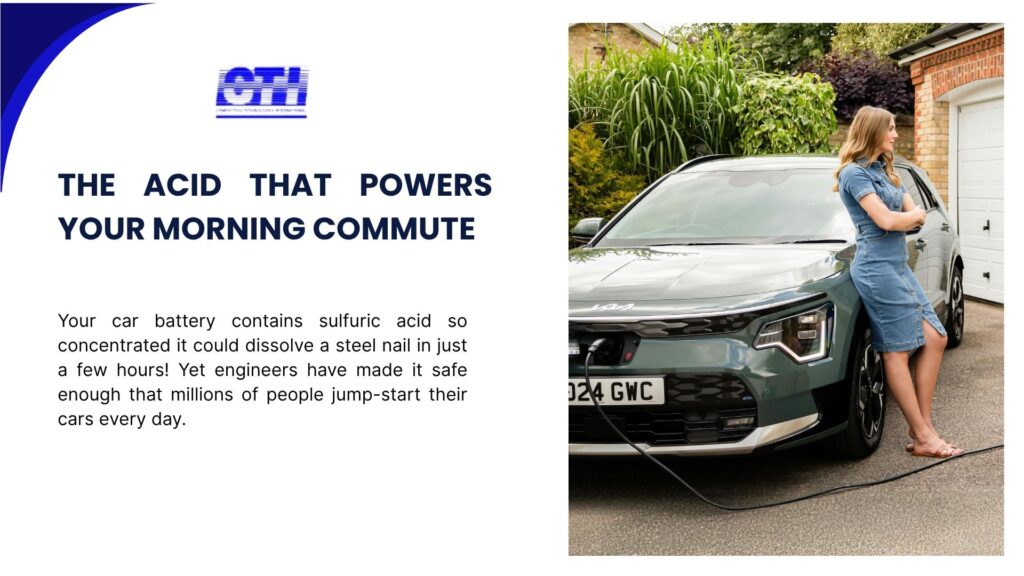
Reactivity: Unstable Chemical Behavior
Reactive waste materials demonstrate unstable behavior under normal conditions or when mixed with water. They cause explosions, generate toxic gases, or undergo violent chemical reactions when disturbed.
Explosives, certain laboratory chemicals, and metal processing byproducts often exhibit reactive properties. Research facilities, mining operations, and chemical manufacturing plants frequently encounter reactive waste materials that require immediate attention.
The EPA designates reactive materials with waste code D003. These materials demand specialized storage conditions, including temperature control, moisture prevention, and isolation from incompatible substances. Emergency response procedures become essential for facilities that handle reactive waste.
Toxicity: Health Impact Assessment
These wastes do exhibit an unstable behavior under ordinary conditions or when mixed with water. This characteristic is the one under which hazardous waste conditions are described.
For example, they explode upon disturbance; generate toxic gases, or undergo violent chemical reactions. Such wastes especially require immediate attention at research facilities, mining operations, and chemical manufacturing plants.
EPA has designated reactive materials as waste code D003. Such materials must be stored under special conditions which include temperature control, the prevention of moisture, and isolation from incompatible substances.
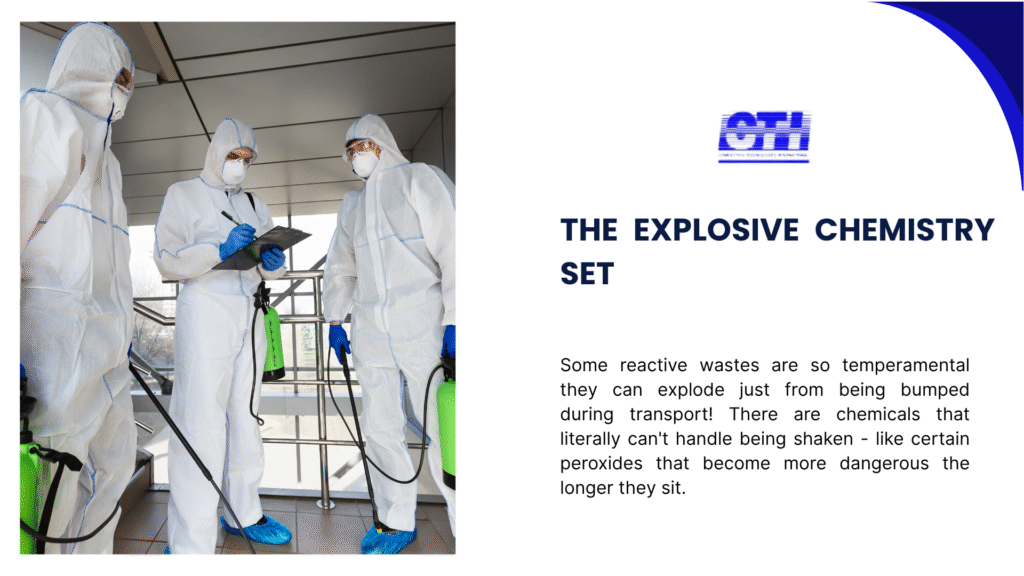
RCRA Hazardous Waste Classification System
The Resource Conservation and Recovery Act implemented a system that classifies hazardous waste materials using four essential principles. The federal guidelines mandate businesses to perform assessments that use particular standards for waste materials before they dispose of them.
The collection of waste data and classification results alongside disposal approaches constitutes the essential documentation that businesses need to keep according to RCRA guidelines.
The RCRA hazardous waste system extends its rules to every type of business operation whether it involves small independent automotive facilities or major industrial facilities.
The professional classification services assist businesses in following regulations and prevent them from incurring expensive penalties for non-compliance.
The services organize testing procedures as well as documentation and disposal processes for companies that do not possess their own waste management expertise.
Testing Methods for Waste Characterization
Laboratory testing determines the exact characteristics of hazardous waste when visual inspection and process knowledge prove insufficient. Professional testing facilities use standardized methods to evaluate ignitability, corrosivity, reactivity, and toxicity.
The flash point test measures ignitability in liquids. pH testing determines corrosivity in both liquid and solid waste. Reactivity testing observes material behavior under controlled conditions. The TCLP procedure measures toxic substances in solid materials.
Small businesses often rely on waste generators’ knowledge and material safety data sheets for initial classification. However, complex or unknown materials typically require professional laboratory analysis to determine proper disposal methods.
| Test Method | Purpose | Typical Cost Range | Turnaround Time |
| Flash Point | Ignitability assessment | $50-150 per sample | 2-5 business days |
| pH Analysis | Corrosivity determination | $25-75 per sample | 1-3 business days |
| Reactivity Screen | Stability evaluation | $100-300 per sample | 3-7 business days |
| TCLP Analysis | Toxicity measurement | $200-800 per sample | 5-10 business days |
Industry-Specific Waste Examples
Different industries generate waste materials with distinct characteristics based on their operational processes.
Manufacturing facilities produce metal shavings, chemical residues, and contaminated oils. Healthcare facilities generate pathological waste, pharmaceutical residues, and contaminated materials.
Automotive repair shops accumulate used oils, brake fluids, and battery acid. Construction companies handle paint waste, adhesives, and treated wood materials.
Each industry faces unique challenges in waste characterization and disposal.
Household hazardous waste disposal requirements often mirror industrial standards on a smaller scale. Residential materials like paint, pesticides, and batteries demonstrate the same characteristics as their commercial counterparts.
Proper Storage and Handling Protocols
Safe storage procedures will avoid any accidents or violations of the law while the waste is awaiting disposal. It is required that incompatible materials be put apart physically to avoid dangerous reactions.
Temperature control will take on a great importance for reactive and ignitable waste types, whereas ventilation must be enough to rid the storage areas of any extant dangerous vapors.
Regular inspections will spot container deterioration before serious problems develop.
Liquid waste disposal involves special containers and handling methods dependent on the nature of the waste. Such liquid materials do pose serious threats because they are mobile in the environment and have the capacity to cause large-scale contamination.
Regulatory Compliance Requirements
Federal and state regulations mandate specific procedures for businesses that generate hazardous waste materials. The EPA requires waste generators to obtain identification numbers, maintain detailed records, and use authorized disposal facilities.
Small quantity generators (less than 1,000 kg per month) face reduced regulatory requirements but must still properly classify their waste materials.
Large quantity generators (1,000 kg or more per month) must comply with comprehensive regulations covering storage, transportation, and disposal.
State environmental agencies often impose additional requirements beyond federal standards. Local regulations may also apply, particularly in areas with sensitive environmental conditions or dense populations.
Safe Disposal Options and Methods
Professional waste disposal companies provide specialized services based on waste characteristics. Treatment methods include incineration, chemical neutralization, and secure landfill disposal. Each method targets specific waste types and characteristics.
Carbon filtration systems remove contaminants from liquid waste streams before disposal. These systems prove particularly effective for organic compounds and certain metals. Proper filtration reduces disposal costs and environmental impact.
Some waste materials qualify for recycling or energy recovery rather than disposal. Metal-containing waste, certain solvents, and oil-based materials often retain economic value through specialized processing methods.
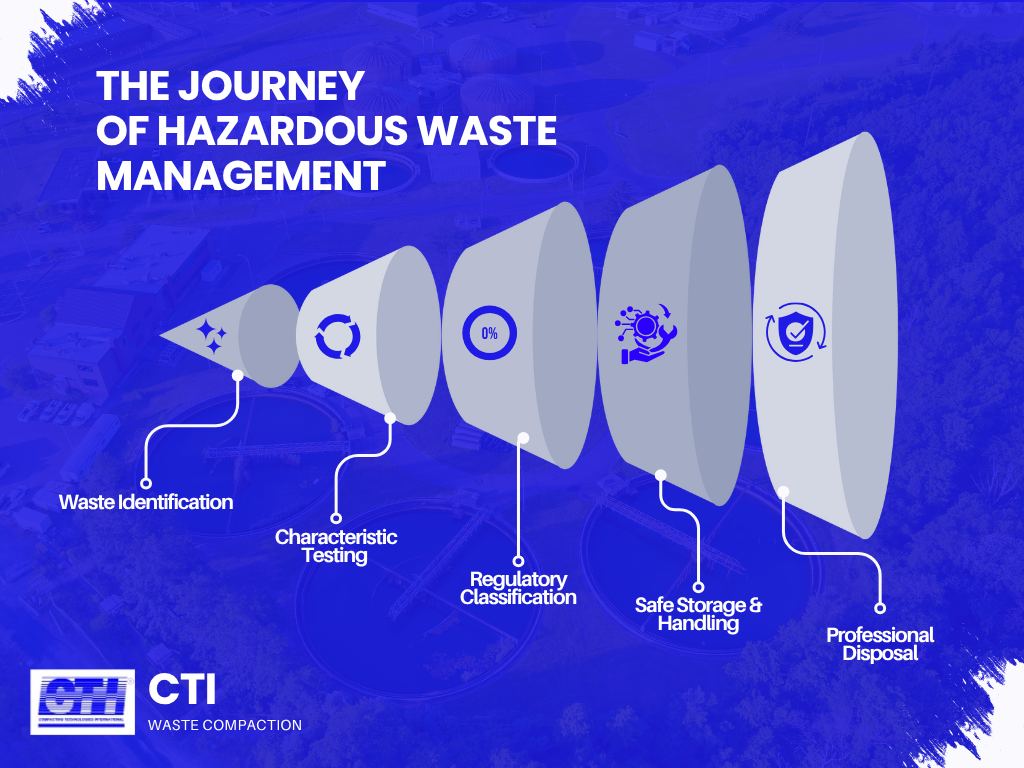
Cost Factors in Hazardous Waste Management
Waste management costs depend on material characteristics, quantity, distance of transport, and disposal methods used.
Disposal of materials that are reactive or toxic generally costs more than those that are ignitable or corrosive. Transportation costs increase in proportion to the distance to the authorized disposal facilities.
Thorough review and proper categorization of waste for disposal will cost the generator between $500 and $2,000. Usually, the services identify less expensive disposal options and save disposal costs.
Small companies should be encouraged to use waste reduction programs, proper segregation practices, and joint disposal arrangements with other local companies to further reduce costs.
Key Takeaways For You As A Business Owners
The characteristics of hazardous waste provide the foundation for safe and legal waste management practices. Proper identification prevents accidents, protects workers, and maintains regulatory compliance.
Regular training keeps employees current on safety procedures and regulatory changes. Documentation systems provide legal protection and facilitate regulatory inspections.
Companies that understand waste characteristics make better decisions about process changes, waste reduction, and disposal options. This knowledge reduces costs, improves safety, and protects the environment for future generations.
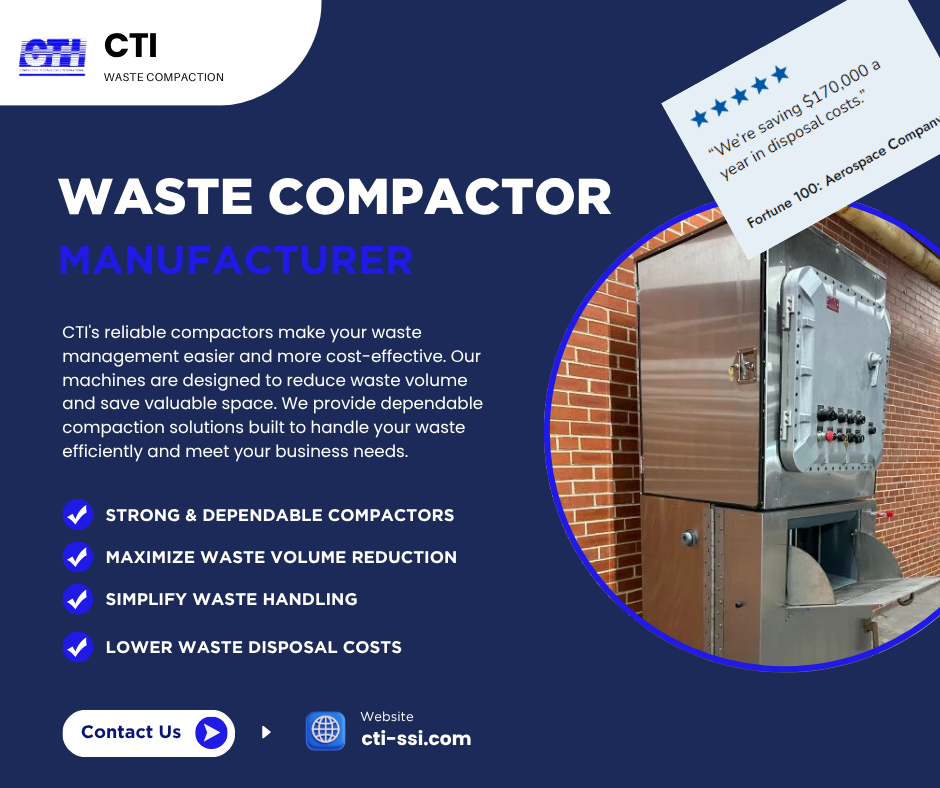
Trust CTI-SSI for Professional Hazardous Waste Management
CTI-SSI brings more than 25 years of experience in the management of hazardous wastes and compliance with environmental laws.
From waste assessment to final disposal, CTI-SSI controls the entire process while strictly complying with federal and state laws.
Our specialist services help businesses reduce costs, increase safety, and keep their communities safe from hazardous material.
Get in touch with CTI-SSI today to discuss hazardous waste management needs and how your business benefits from professional services.


